Tricolor or triband flags have three broad stripes of color. Historically, countries that rebelled against monarchies and established themselves as republics often chose these kinds of flags. Later, countries that rebelled against colonialism chose them.
Today, 26 countries of the world have tricolor or triband flags. We list and describe each below, and include a link to more information. And there’s no way in the world you’ll guess what the last one is…
Armenia

©Lina Reshetnyk/Shutterstock.com
The Armenian flag consists of three horizontal bands of equal width, red on the top, blue in the middle, and orange on the bottom. The colors of the Armenian flag have a symbolic meaning. The general belief is that they represent the natural beauty of Armenia. Red represents the Armenian Highland, blue: the Armenian sky, and orange: the talented and hard-working Armenian people.
Find out more about the Armenian flag.
Austria
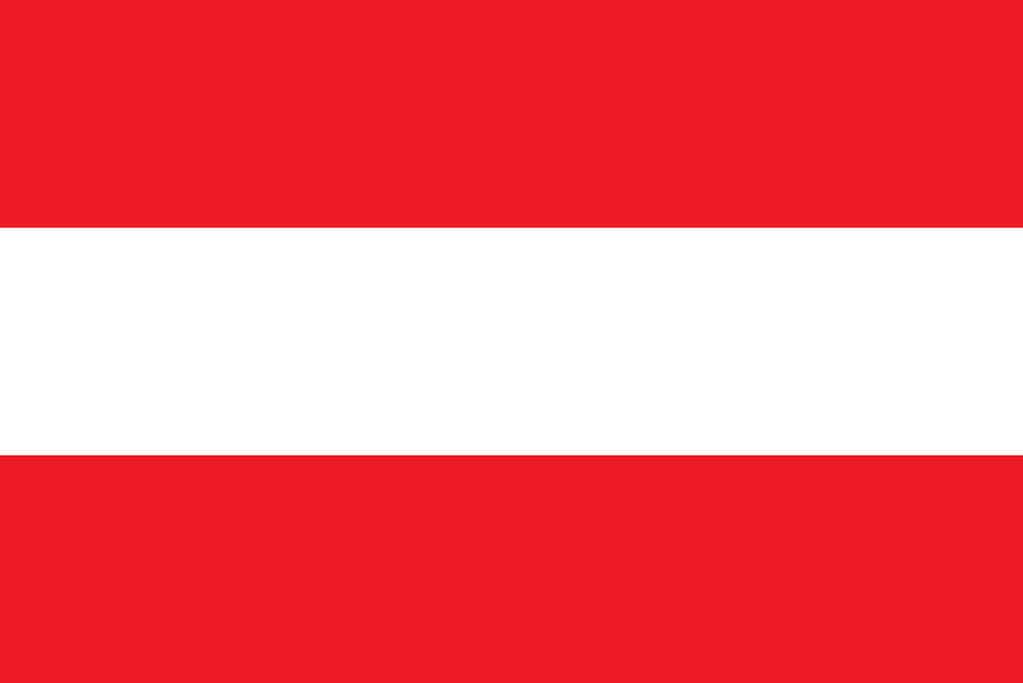
©iStock.com/VanReeel
The flag of Austria consists of three equal horizontal bands of red, white, and red. The red and white colors are believed to have been chosen to represent the House of Habsburg, which ruled Austria for many centuries. Legend has it that in the 12 century during the Siege of Acre, Duke Leopold V of Austria wore a white coat into battle. After intense fighting, his coat was completely drenched in blood, but when he took his belt off there was an unstained white band across his waist. This was claimed as the inspiration for the Austrian flag.
Find out more about the Austrian flag.
Belgium

©Faievych Vasyl/Shutterstock.com
The flag of Belgium consists of three equal vertical bands of black, yellow, and red. The colors of the Belgian flag are believed to have been chosen to represent the country’s coat of arms, which features a golden lion on a black field. Black stands for a black lion; yellow represents a golden lion, and red represents the tongue and claws of the lion. The colors are also said to represent three regions of Belgium.
Find out more about the Belgian flag.
Benin
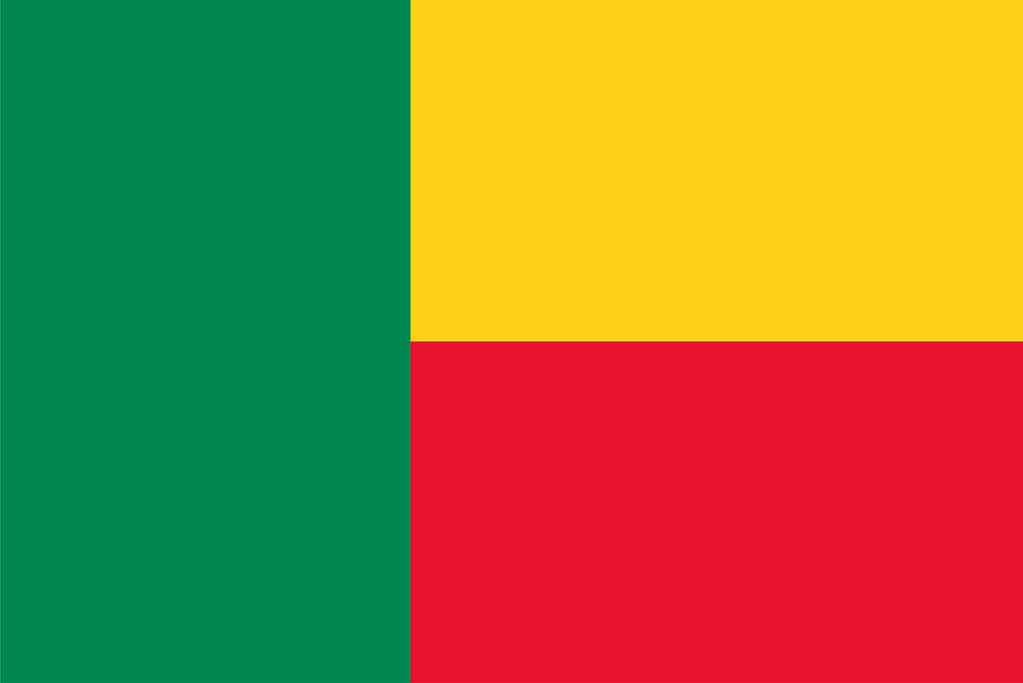
©iStock.com/TAK
The flag of Benin is designed with two equal horizontal bands of yellow and red, with a vertical green band on the hoist side. Green represents hope, agriculture, and the natural resources of the country, while yellow represents wealth and prosperity. Red commemorates the blood of those who died fighting for independence from France. They achieved that independence in 1960. Benin adopted its flag on August 1, 1959, and the flag has remained unchanged since then.
Find out more about the flag of Benin.
Bulgaria
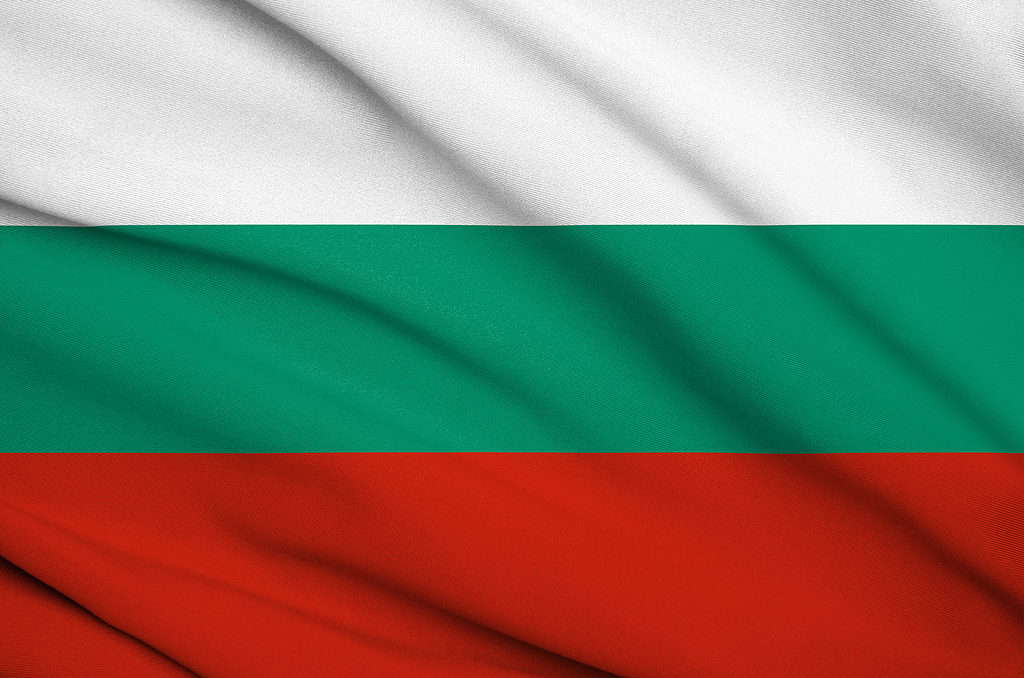
©MriMan/Shutterstock.com
The first version of the flag of Bulgaria dates to the 19th century when the nation won independence from the Ottoman Empire. The flag of Bulgaria consists of three equal horizontal bands of white, green, and red. What stands for peace, neutrality, love, purity, brotherhood, and freedom. Green is reminiscent of the agricultural abundance of the country, and red represents the Bulgarian people’s courage and bravery in their struggle for freedom.
Find out more about the Bulgarian flag.
Canada

©iStock.com/RM80
The flag of Canada, also known as the Maple Leaf flag, consists of a red field with a white square in the center, which contains a red maple leaf. Canada officially adopted the Maple Leaf flag as their national flag on February 15, 1965, after a long and contentious debate. Prior to this, Canada had used the British Union Jack as its national flag. The maple leaf is a symbol of Canada. The country’s coat of arms features it, as do the country’s coins and stamps. The red of the flag represents the bravery and valor of the Canadian people, while the white represents peace and purity.
Find out more about the Canadian flag.
Croatia
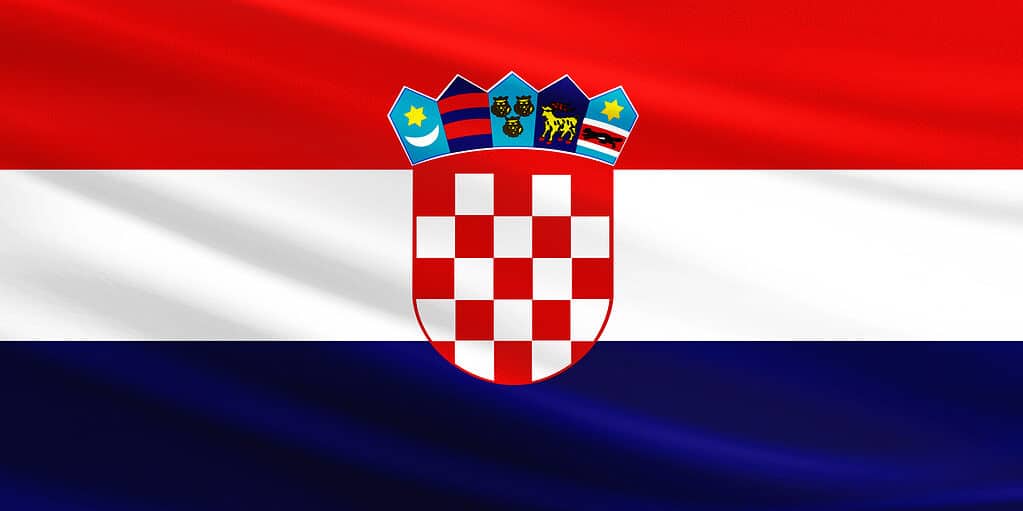
©Osman Bugra Nuvasil/Shutterstock.com
Croatia adopted its current flag in 1990 during its fight for independence from Yugoslavia. It has three horizontal stripes of red, white, and blue. These Pan-Slavic colors were included in Croatian flags in 1848. One interpretation of the colors is that red represents the Croatian people and their sacrifice and bravery, white represents peace and purity, and blue represents the Adriatic Sea and the country’s natural beauty. The central shield on the flag represents the original flag of the Kingdom of Croatia and the crown above it depicts the ancient coat of arms of Croatia, Dubrovnik, Dalmatia, Istria, and Slavonia.
Find out more about the Croatian flag.
Ecuador
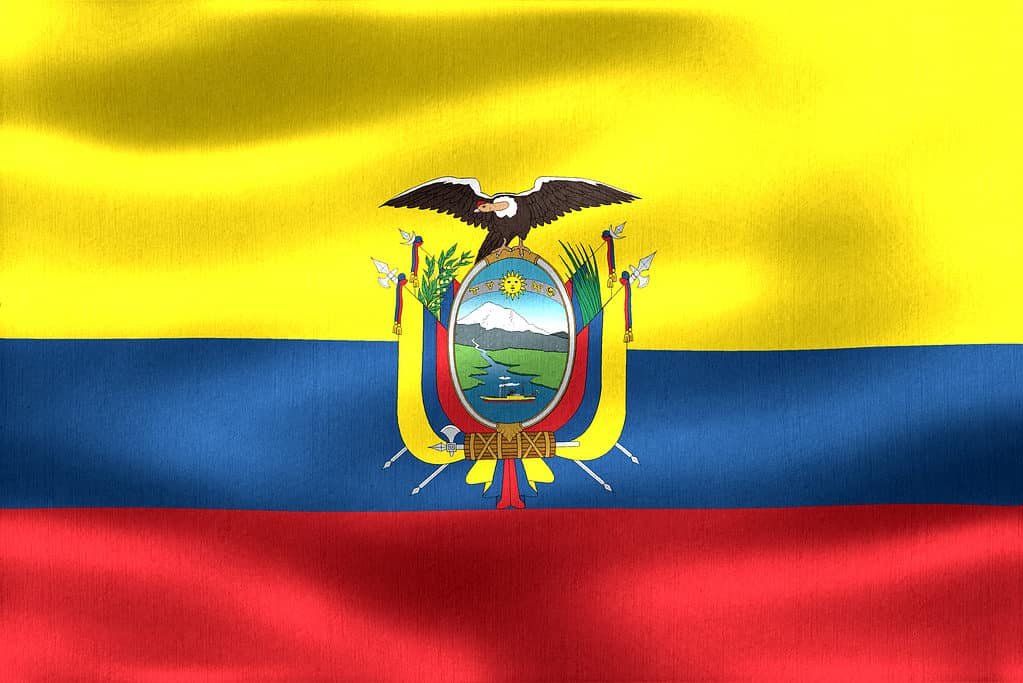
©MP_Foto/Shutterstock.com
The flag of Ecuador was adopted on September 26, 1860, shortly after the country gained independence from Spain. It includes three horizontal bands of equal width, yellow on the top, blue in the middle, and red on the bottom. Yellow represents the country’s natural resources, blue represents the sea, and red represents the blood of those who died fighting for independence. The flag also features the Ecuadorian coat of arms in the center of the blue band, which consists of a shield with a condor perched on top. The condor represents the majesty and power of Ecuador, while the shield represents the country’s natural resources and industry.
Find out more about the flag of Ecuador.
France

©iStock.com/-ELIKA-
The flag of France, also known as the French Tricolor, consists of three equal vertical bands of blue, white, and red. It is a simple design that is rich in meaning and has been the inspiration for many other European and world flags.
The flag has blue, white, and red vertical stripes. The white stripe originates from the original French flag. The red and blue stripes are from the coat of arms of Paris, with blue the color of Saint Martin and red the color of Saint-Denis. It has also been suggested the colors represent the three estates of pre-revolutionary France. These are white for the clergy, red for the nobility, and blue for the bourgeoisie. They are arranged so that blue is placed first and red is last, in keeping with the revolutionary government’s desire to elevate the working class.
Find out more about the French flag.
The Gambia
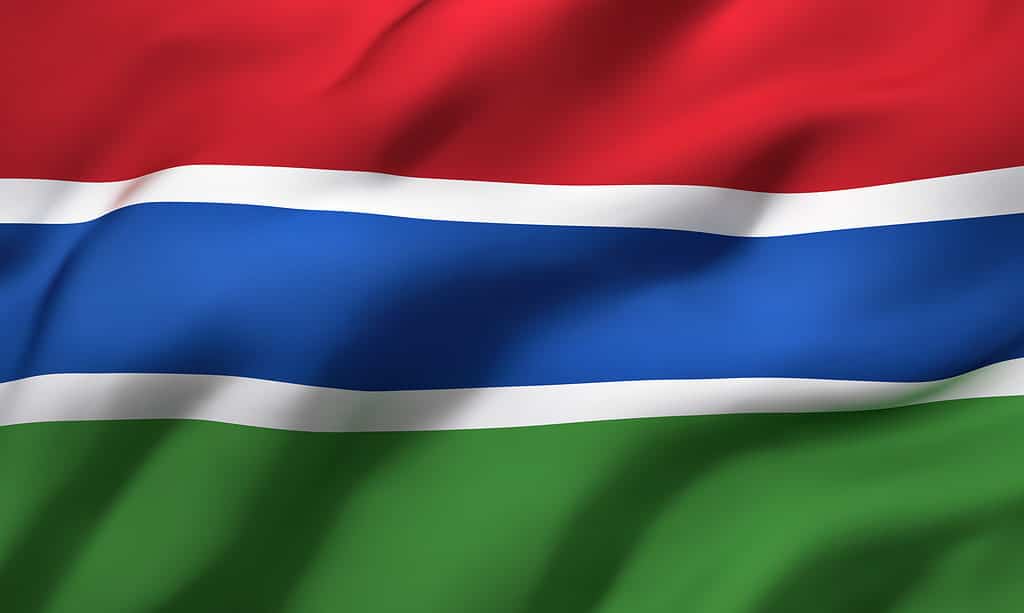
©iStock.com/titoOnz
The flag of The Gambia was adopted on February 18, 1965, shortly after the country gained independence from Britain. It has remained unchanged since then. The flag of The Gambia consists of three horizontal bands of equal width, red on the top, blue in the middle, and green on the bottom. Red stands for the African sun, blue: the river Gambia, and green: the country’s lush natural resources and agriculture. The flag also features a green five-pointed star in the center of the blue band, which represents the unity of the people of The Gambia.
Find out more about the flag of The Gambia.
Germany

©Osman Bugra Nuvasil/Shutterstock.com
The modern flag of Germany is a tricolor consisting of three equal horizontal bands of black, red, and gold. The German Confederation, a loose association of German-speaking states, first adopted the flag in 1848. The German Empire later officially adopted it in 1871.
The colors of the flag have a long and complex history. The black and gold colors were inspired by the colors of the Holy Roman Empire, which included much of modern-day Germany. Red was added to the flag in the 19th century and was inspired by the liberal revolutions that swept Europe at that time.
Find out more about the German flag.
Hungary

©Savvapanf Photo/Shutterstock.com
The flag of Hungary is a tricolor consisting of three equal horizontal bands of red, white, and green. Hungary officially adopted the flag on October 12, 1957. The colors, though, have a long history dating back to the Middle Ages. The color red is believed to symbolize Hungary’s struggle for independence and freedom. White symbolizes honesty and purity, while green represents hope and the country’s natural beauty.
Find out more about the Hungarian flag.
India
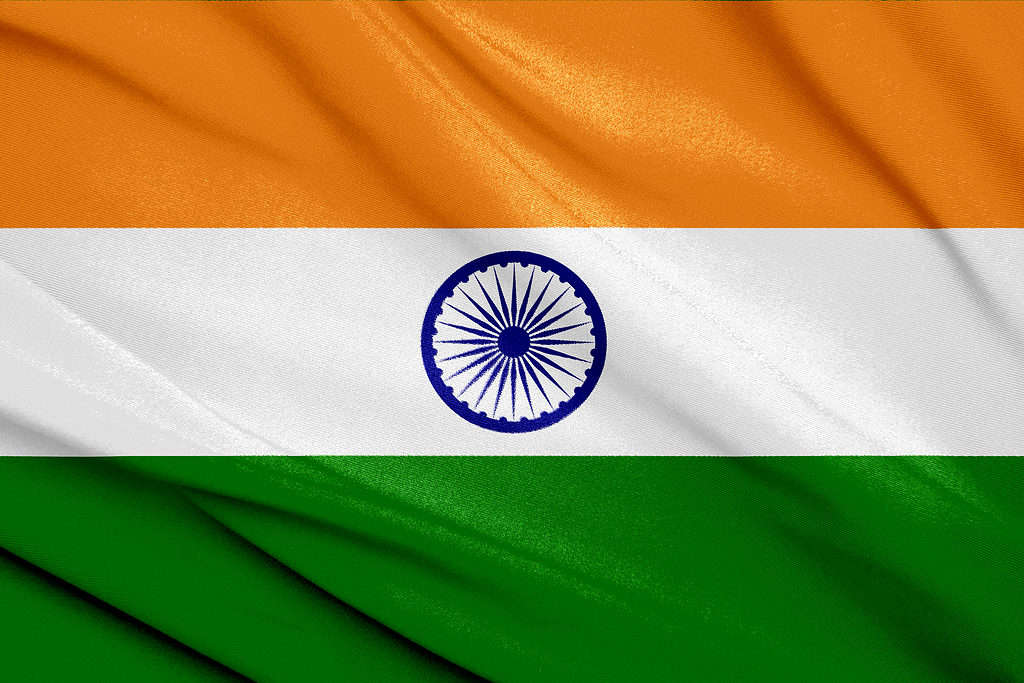
©MriMan/Shutterstock.com
The flag of India was proposed by independence icon Mahatma Gandhi in 1921. The original proposal was for red and green stripes representing the Hindu and Muslim communities with a traditional spinning wheel in the center representing self-reliance.
The final approved version gave new meanings to the colors. Saffron represents courage, sacrifice, and the spirit of renunciation; white represents purity and truth; and green represents faith and fertility. The spinning wheel was replaced with the Asoka Chakra, a 24-point star that symbolizes the eternal wheel of dharma, or law.
Find out more about the flag of India.
Ireland

©iStock.com/Oleksii Liskonih
The flag of Ireland is a vertical tricolor of green, white, and orange. Green, a traditional Irish color, represents the Irish nationalist movement. Orange represents the minority Protestant community. White represents hope for peace and reconciliation between the two communities. The current design of the flag was officially adopted by the Irish Free State, a self-governing state within the British Empire, in 1922.
Find out more about the Irish flag.
Italy

©Philipp Dase/Shutterstock.com
The flag of Italy is a tricolor consisting of three equal vertical bands of green, white, and red. The flag was officially adopted on January 1, 1948, following the end of World War II and the abolition of the fascist government.
The colors of the flag have a long and complex history. The green color is believed to represent the country’s natural beauty, while white represents peace and purity. Red stands for the blood of Italian soldiers who sacrificed their lives for their country.
Find out more about the Italian flag.
Madagascar

©Foxytail/Shutterstock.com
The flag of Madagascar is a vertical tricolor of green, white, and red. The flag was officially adopted on October 14, 1958, following Madagascar’s independence from France. The current design of the flag is based on the design of the French Tricolor, which uses the same colors.
The green of the flag stands for the country’s natural environment and its agriculture, while the white represents purity and justice. The red color symbolizes the country’s struggle for independence and the sacrifices made by its people in achieving it.
Find out more about the flag of Madagascar.
Mexico

©H.studio/Shutterstock.com
The flag of Mexico is a vertical tricolor of green, white, and red. The flag was officially adopted on September 16, 1968. The current design of the flag is based on the design of the Tricolor of the Mexican Army, which was used during the Mexican War of Independence.
The green in the flag represents the country’s independence and hope for the future, while the white represents the Roman Catholic religion and the purity of the Mexican people. The red symbolizes the blood of the Mexican people and their sacrifices in the fight for independence.
Find out more about the Mexican flag.
Namibia

©Faievych Vasyl/Shutterstock.com
The flag of Namibia is a horizontal tricolor of blue, red, and green. The current design of the flag was chosen in a national competition held in 1989 and the flag was officially adopted on March 21, 1990, following Namibia’s independence from South African rule.
The blue represents the clear Namibian sky and the Atlantic Ocean, while the red represents the blood of the Namibian people and their struggle for independence. Green symbolizes the country’s natural environment and its abundant vegetation.
Find out more about the Namibian flag.
Nigeria

©Tatohra/Shutterstock.com
The flag of Nigeria is a horizontal tricolor of green, white, and green. Nigeria adopted the flag on October 1, 1960, following Nigeria’s independence from British rule.
The green represents the country’s natural environment and its abundant vegetation and white represents peace and unity. The white stripe in the center of the flag is wider than the two green stripes on either side.
The current design of the flag, based on traditional Nigerian colors, was chosen in a national competition held in 1959.
Find out more about the Nigerian flag.
Netherlands
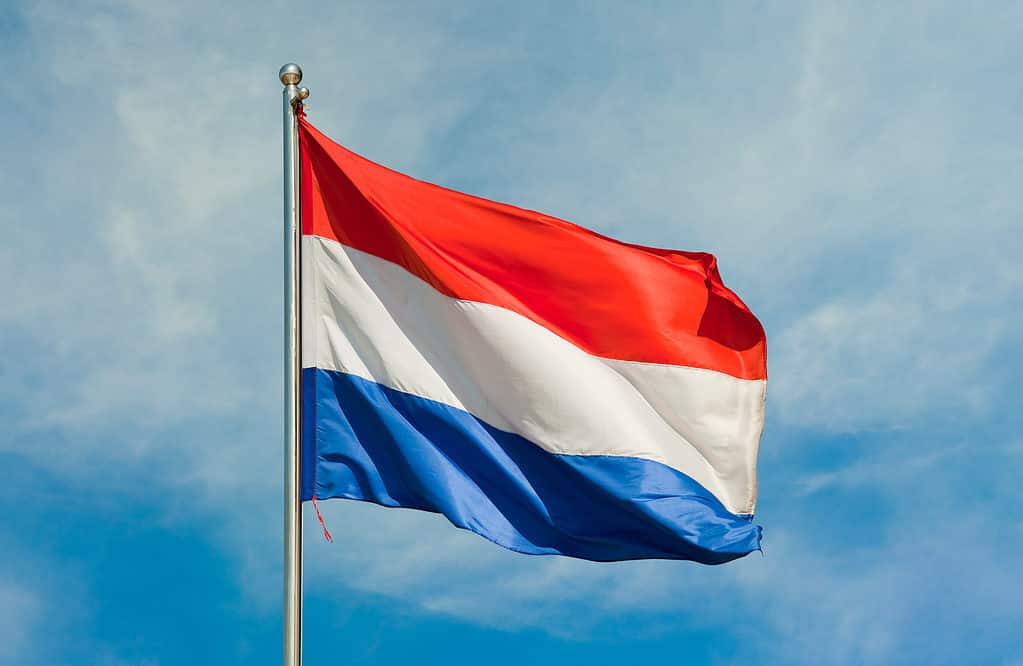
©iStock.com/macky_ch
The flag of the Netherlands is a horizontal tricolor of red, white, and blue. The Netherlands officially adopted the flag on February 19, 1937, but the colors have a long history dating back to the 16th century.
Red recalls the Burgundy dynasty, which ruled the Netherlands in the Middle Ages. White represents the House of Nassau, which has played a prominent role in the country’s history. Blue signifies the country’s natural environment and its waterways.
The current design of the flag is based on the design of the Dutch Tricolor, which was first used during the Dutch Revolt against Spanish rule in the late 16th century.
Find out more about the Dutch flag.
Oman

©
The flag of Oman is a horizontal tricolor of green, white, and red. Oman officially adopted the current design of the flag on October 17, 1970, following the country’s independence from Portuguese rule. Sultan Qaboos bin Said, the ruler of Oman at the time, chose the current design of the flag.
The green color represents Islam, which is the dominant religion in Oman; white stands for peace and purity; red commemorates the country’s battles for independence and the sacrifices made by its people.
Find out more about the flag of Oman.
Peru
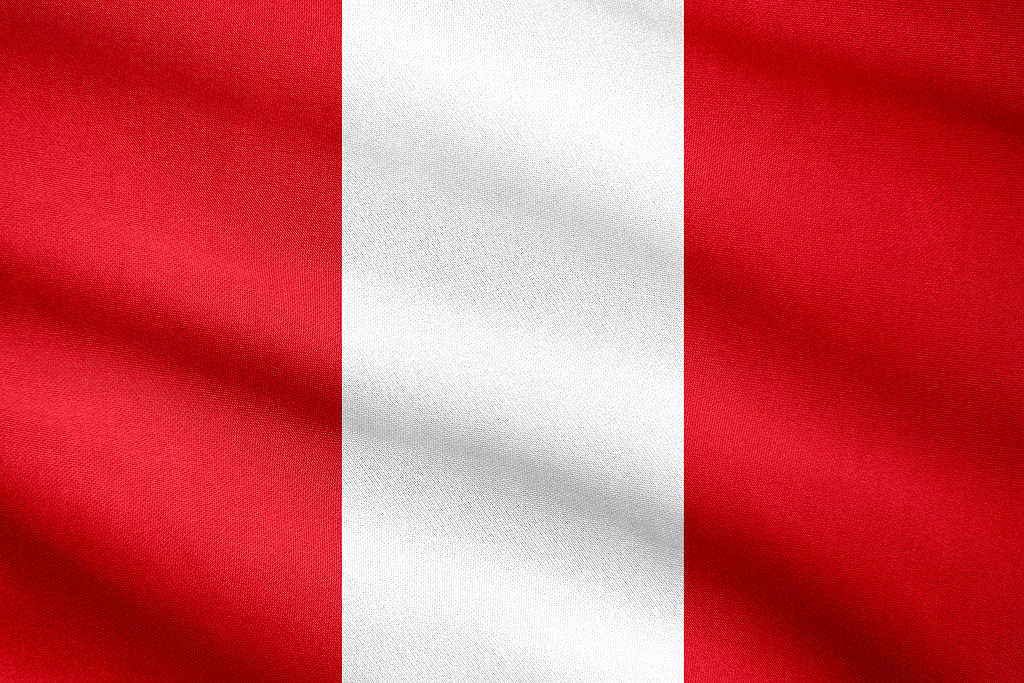
©MriMan/Shutterstock.com
The flag of Peru consists of three vertical bands of equal width. The left band is red, the middle band is white, and the right band is red. Peru officially adopted the current design of the flag on February 25, 1825, following Peru’s independence from Spain.
The red band represents the blood of the heroes who fought for Peru’s independence, while the white band represents peace and purity.
Over the years, the flag of Peru has undergone several changes, including the addition of a coat of arms in the center of the flag.
Find out more about the Peruvian flag.
Romania
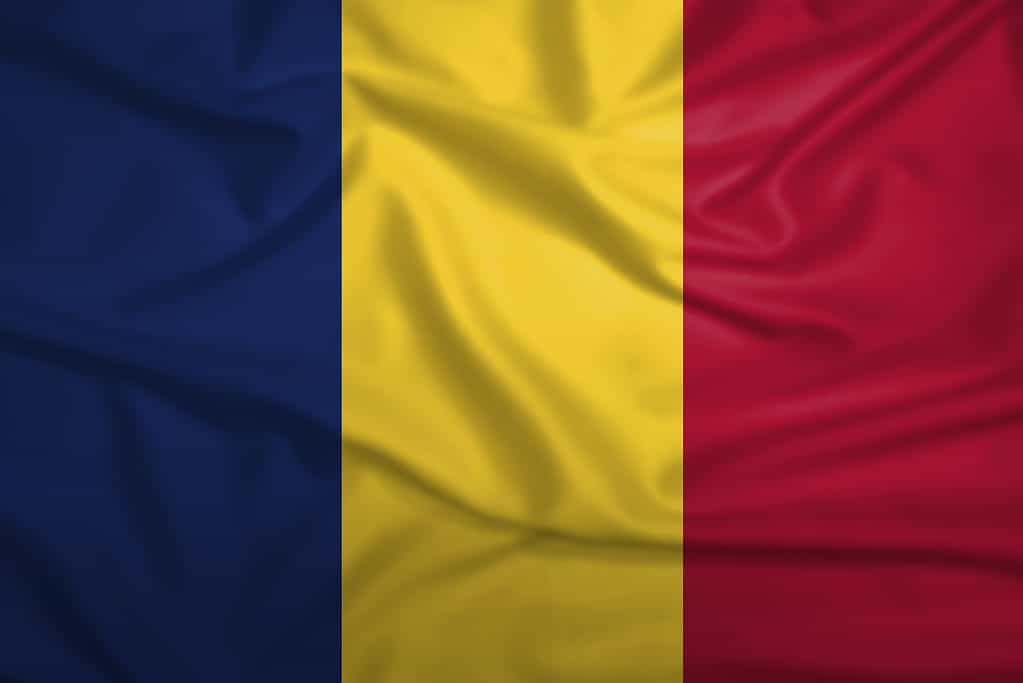
©ASUWAN MASAE/Shutterstock.com
The flag of Romania is a blue, yellow, and red tricolor. The flag is a vertical triband with blue, yellow, and red arranged from the hoist side to the fly side. Symbolically, blue represents the sky, yellow represents fields of wheat, and red represents the blood of those who fought and died for the country’s independence and unity.
Romania officially adopted the current design of the flag on December 27, 1989, following the collapse of communism in Romania. Prior to that, Romania had used a number of different flags. These included a tricolor flag with a socialist symbol on the middle yellow stripe. During the Romanian revolution against communism, rebels cut out the communist symbol and flew the flag with a hole in the middle until the manufacturing of new flags.
Find out more about the Romanian flag.
Russia
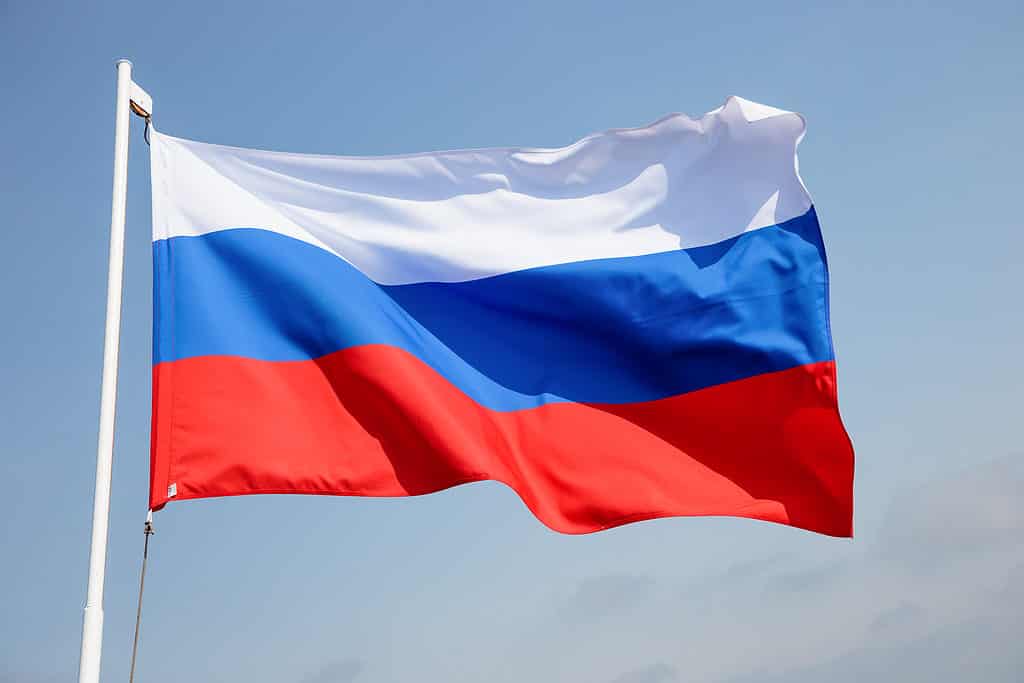
©pudiq/Shutterstock.com
The flag of Russia is a tricolor consisting of three equal horizontal bands of white, blue, and red. The Russian Tricolor is an occasional name for the flag.
The Russian Navy, started using the tricolor flag in 1705. The colors represent the three classes of Russian society: the nobility, the clergy, and the common people. This became the national flag of the Russian Empire in the late 18th century until the communist hammer and sickle design replaced it in 1917. After the collapse of the Soviet Union in 1991, the tricolor flag was restored as the national flag of the Russian Federation.
Find out more about the Russian flag.
Serbia
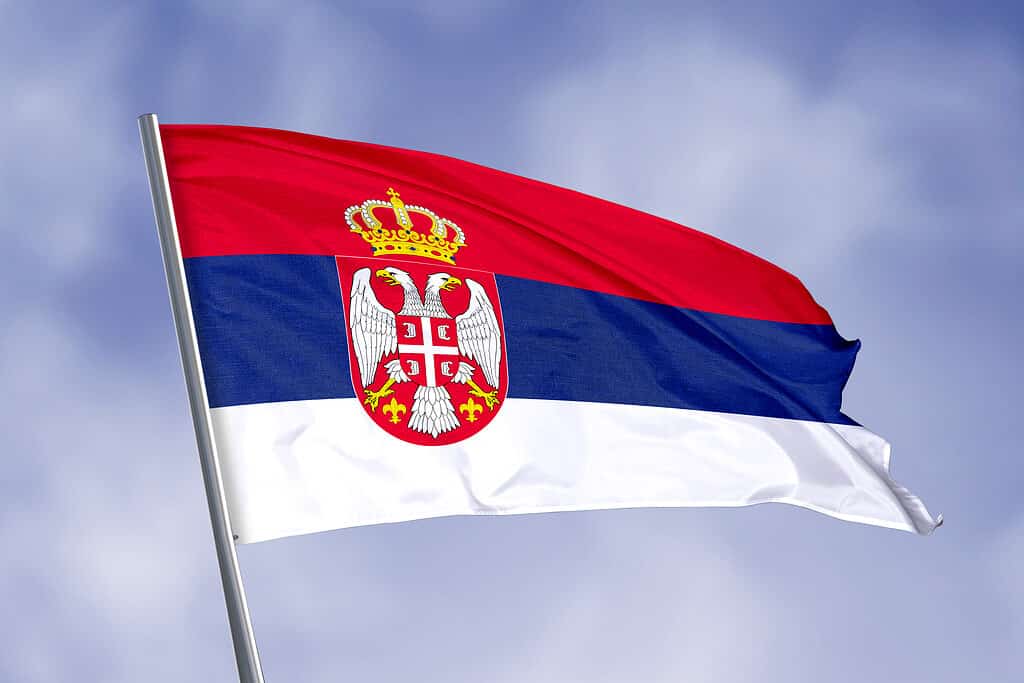
©tatohra/Shutterstock.com
The flag of Serbia is a tricolor consisting of three equal horizontal bands of red, blue, and white. The flag was officially adopted as the national flag of Serbia in 2003, following the breakup of Yugoslavia.
The red band represents the bloodshed and sacrifice of the Serbian people in their struggle for freedom and independence. The blue band represents hope and the sky, while the white band represents peace and purity.
Find out more about the Serbian flag.
United Arab Emirates

©Maciej Bledowski/Shutterstock.com
The flag of the United Arab Emirates (UAE) consists of three equal horizontal bands of green, white, and black. The green represents fertility and agriculture, the white represents peace and purity, and the black represents the defeat of the enemies of the UAE. The flag also includes a red vertical band on the hoist side. This red band is known as the “pan-Arab” color and is used to represent the unity of the Arab people.
Find out more about the flag of the United Arab Emirates.
Bonus: A Flag for Mars?
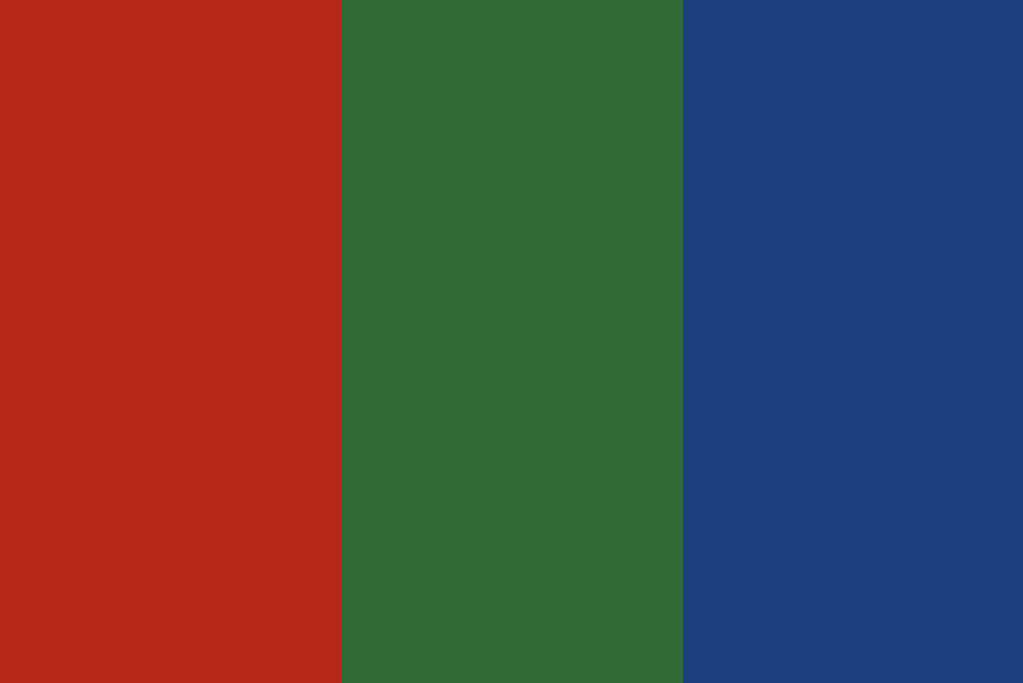
©Original: Pascal Lee, Vector: TakisA1/Wikimedia Commons – License
Human beings have not yet set foot on Mars but already we’re dreaming of it. In 1999 a NASA engineer, Pascal Lee, proposed a Flag of Mars with vertical bands of red, green, and blue. These colors represent a future three-stage process of terraforming the planet into an earth-like environment. So it seems like tricolor flags are here to stay in our world, and maybe in future worlds as well.
Up Next…
- Countries with Striped Flags
- 19 Different Flags that Use Spiral Designs
- Different Examples of Flags with Diamonds
The post 26 Countries With Tricolor (Triband) Flags appeared first on AZ Animals.
from Animal News, Facts, Rankings, and More! - AZ Animals https://ift.tt/hMr3zoC